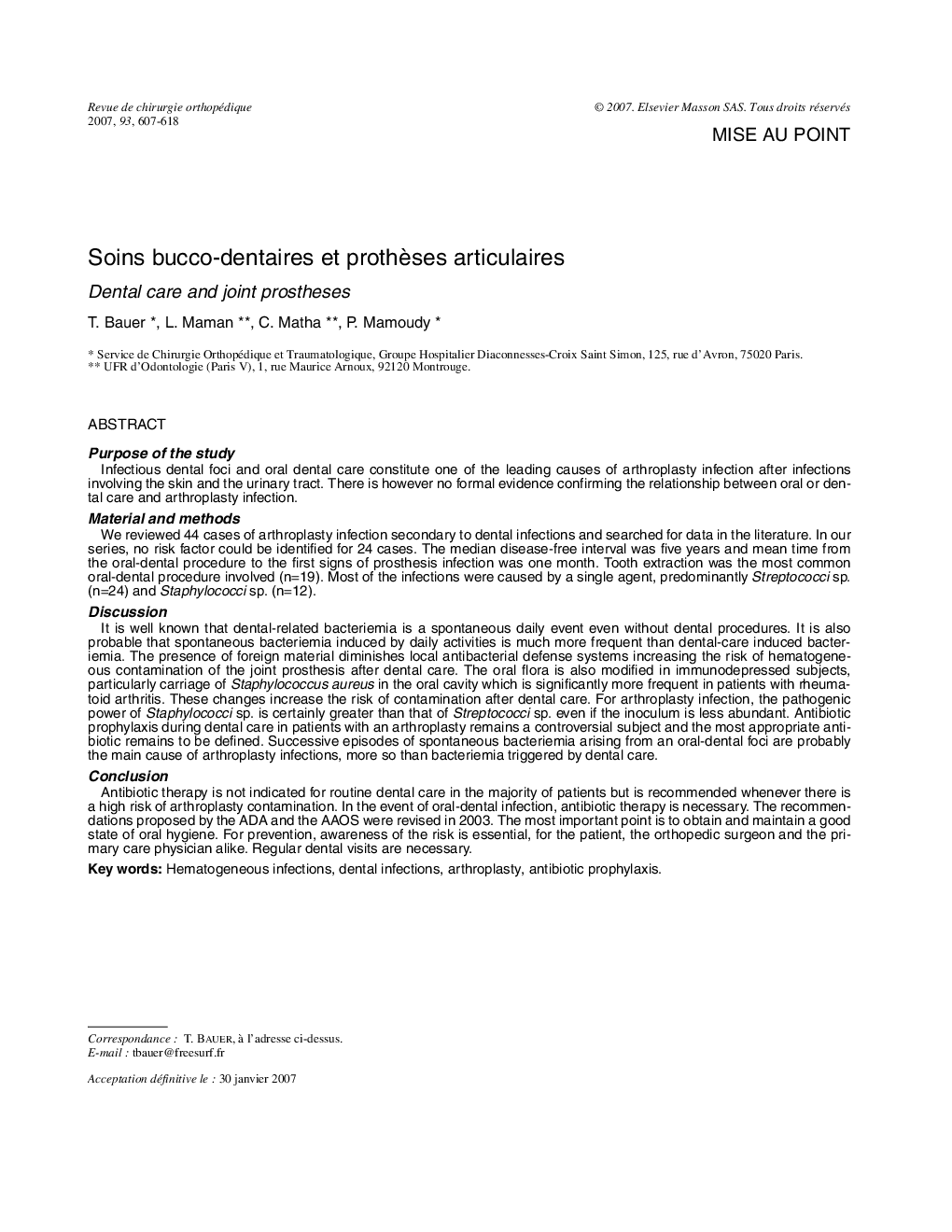| کد مقاله | کد نشریه | سال انتشار | مقاله انگلیسی | نسخه تمام متن |
|---|---|---|---|---|
| 4088581 | 1268109 | 2007 | 12 صفحه PDF | دانلود رایگان |

RésuméLes foyers infectieux dentaires et les soins bucco-dentaires représentent une des principales causes d’infection de prothèse articulaire par contamination secondaire, mais leur physiopathologie et les moyens de prévention ne sont pas clairement définis. À partir d’une série et d’une revue de la littérature, 44 cas d’infections d’origine bucco-dentaire sur prothèses articulaires ont pu être analysés. Dans plus de la moitié des cas (24 cas), aucun facteur de risque n’était retrouvé. Les extractions dentaires représentaient les actes les plus fréquemment mis en cause pour l’origine de l’infection de prothèse (19 cas). Sur le plan microbiologique, les infections de prothèses articulaires étaient essentiellement monomicrobiennes (41 cas) et le streptocoque était le germe le plus fréquent (24 cas). Les staphylocoques étaient retrouvés dans 12 cas.La plupart des bactériémies d’origine dentaire sont spontanées ou dues aux brossages quotidiens plutôt qu’aux soins dentaires. En fait, ce sont plus les successions de bactériémies spontanées d’origine bucco-dentaire qui sont à l’origine des contaminations de prothèse que les bactériémies engendrées par les soins. L’antibioprophylaxie n’est pas indiquée pour des soins dentaires de routine chez la plupart des patients, mais elle est indiquée chez les patients à haut risque d’infection ou lors de gestes invasifs à haut risque de bactériémie. En cas d’infection bucco-dentaire, l’antibiothérapie est nécessaire. Le point le plus important est d’obtenir et de maintenir pour chaque patient un bon niveau d’hygiène dentaire. Pour la prévention de ce type d’infections, il faut sensibiliser le patient (mais aussi le chirurgien orthopédiste et le médecin traitant) pour qu’il maintienne cette hygiène constante après la mise en place de la prothèse. Des visites régulières chez le chirurgien-dentiste sont nécessaires.
Purpose of the studyInfectious dental foci and oral dental care constitute one of the leading causes of arthroplasty infection after infections involving the skin and the urinary tract. There is however no formal evidence confirming the relationship between oral or dental care and arthroplasty infection.Material and methodsWe reviewed 44 cases of arthroplasty infection secondary to dental infections and searched for data in the literature. In our series, no risk factor could be identified for 24 cases. The median disease-free interval was five years and mean time from the oral-dental procedure to the first signs of prosthesis infection was one month. Tooth extraction was the most common oral-dental procedure involved (n=19). Most of the infections were caused by a single agent, predominantly Streptococci sp. (n=24) and Staphylococci sp. (n=12).DiscussionIt is well known that dental-related bacteriemia is a spontaneous daily event even without dental procedures. It is also probable that spontaneous bacteriemia induced by daily activities is much more frequent than dental-care induced bacteriemia. The presence of foreign material diminishes local antibacterial defense systems increasing the risk of hematogeneous contamination of the joint prosthesis after dental care. The oral flora is also modified in immunodepressed subjects, particularly carriage of Staphylococcus aureus in the oral cavity which is significantly more frequent in patients with rheumatoid arthritis. These changes increase the risk of contamination after dental care. For arthroplasty infection, the pathogenic power of Staphylococci sp. is certainly greater than that of Streptococci sp. even if the inoculum is less abundant. Antibiotic prophylaxis during dental care in patients with an arthroplasty remains a controversial subject and the most appropriate antibiotic remains to be defined. Successive episodes of spontaneous bacteriemia arising from an oral-dental foci are probably the main cause of arthroplasty infections, more so than bacteriemia triggered by dental care.ConclusionAntibiotic therapy is not indicated for routine dental care in the majority of patients but is recommended whenever there is a high risk of arthroplasty contamination. In the event of oral-dental infection, antibiotic therapy is necessary. The recommendations proposed by the ADA and the AAOS were revised in 2003. The most important point is to obtain and maintain a good state of oral hygiene. For prevention, awareness of the risk is essential, for the patient, the orthopedic surgeon and the primary care physician alike. Regular dental visits are necessary.
Journal: Revue de Chirurgie Orthopédique et Réparatrice de l'Appareil Moteur - Volume 93, Issue 6, October 2007, Pages 607-618